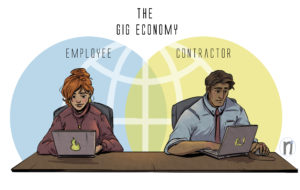info@northstarcomms.com
Chances are it’s already that big: the gig economy and what it means for employee communications and engagement

Heads up, employee communicators. There’s a big change wave here, demanding we change how we think about applying our craft to an exploding number of contract workers.
It’s called the gig economy — the trend of employees leaving the relative security of corporate jobs, hanging their own shingles, and working as contractors on temporary assignments. Essentially, they’re taking “gigs” — with knowledge-intensive industries and creative occupations representing the largest and fastest-growing segments of the freelance economy.
In fact, there already are almost 162 million of them in North America and Western Europe, which represents 20-30 percent of the working population, according to the McKinsey Global Institute.
If we weren’t challenged enough to engage a workforce that shows up to the same place every day as full time employees, consider this: how about having close to a third of employees who don’t have the same benefits plan, are working for your company a few weeks or months before moving on, don’t necessarily show up to work in the same place and don’t know the culture? Think their skin in the game is the same? Think full-time employees who work with them will treat them differently? Think they’ll fit right in to the culture, values and operating norms?
Those are some big questions that — left unanswered or addressed poorly — could yield poor performance, internal strife and increased ethics and compliance violations. Addressed correctly, employee communicators — in partnership with their HR organizations — can be heroes. And to be clear, it’s not all sunshine and roses for workers in the gig economy, as Bloomberg points out. There are significant potential labor issues in different parts of the world, according to the International Labor Organization (ILO), such as gig workers not making even minimum wage.
I have to admit that as a corporate communicator, I saw the trend of increased contract labor, but didn’t realize the magnitude of change (and the attention it’s getting) until this spring, when the topic popped up several times with the Conference Board’s Change and Transformation Council. It got me thinking that this is a real opportunity for employee/change communicators to proactively solve a big business issue before being dragged into a crisis. So here are four things we can do today.
1. Understand who this growing workforce is. The Harvard Business Review a few months ago shared its findings on what motivates workers in the gig economy. The more we understand the emerging needs of this rapidly growing worker base, the better we can shape and influence discussion around policies, tools and processes to help them do the work they’re employed to do, and to help full-time employees engage them in meaningful ways.
2. Engage our HR partners. Chances are that HR already is thinking about this issue — a lot. But communicators have an opportunity to bring unique insights to the table about how our discipline is uniquely positioned to drive needed changes, to articulate what’s happening and why.
3. Look at your own communications practices and policies in a new light. Everything from channels that reach a gig economy workforce, to policies that guide their engagement with the content provided for them is fair game. Mobile communication is no longer optional, so if you’re struggling with a full-time workforce on this issue, consider the gig economy worker adding a lot of fuel to that flame. Along with HR, IT must be part of the team that carefully develops solutions.
4. Focus on cultural norms and values — with specific emphasis on speed to immerse contractors and remind employees. This sounds much easier to do than it really is. Figuring out how to immerse larger and growing numbers of temporary/contract employees into “how we do things here” is a tough job under ideal circumstances. We know it takes time for new workers to acclimate, but we need to find ways to accelerate the learning curve. The pace and volume of new gig workers temporarily joining companies demands well-constructed, efficient and engaging communications strategies. At the same time, helping existing full-time employees to engage, partner with, manage and support gig workers is an equally daunting task. It’s easy to imagine the natural tension — and friction — between employees and gig workers. It’s an opportunity for communications and change professionals to really solve a significant people issue before it becomes a real problem.
If you’re already working in this space or on these issues, well done. If you’re not, consider this one of the bigger — if not biggest — strategic issues looming around the corner for organizational communications. It’s all about risk, strategy and proactively solving business challenges. I can’t think of a better, more immediate opportunity to show the value we bring, and strengthen our seat at the table.